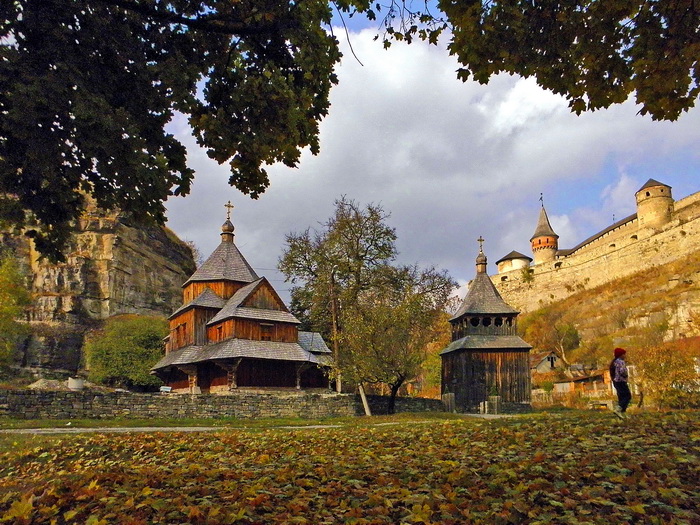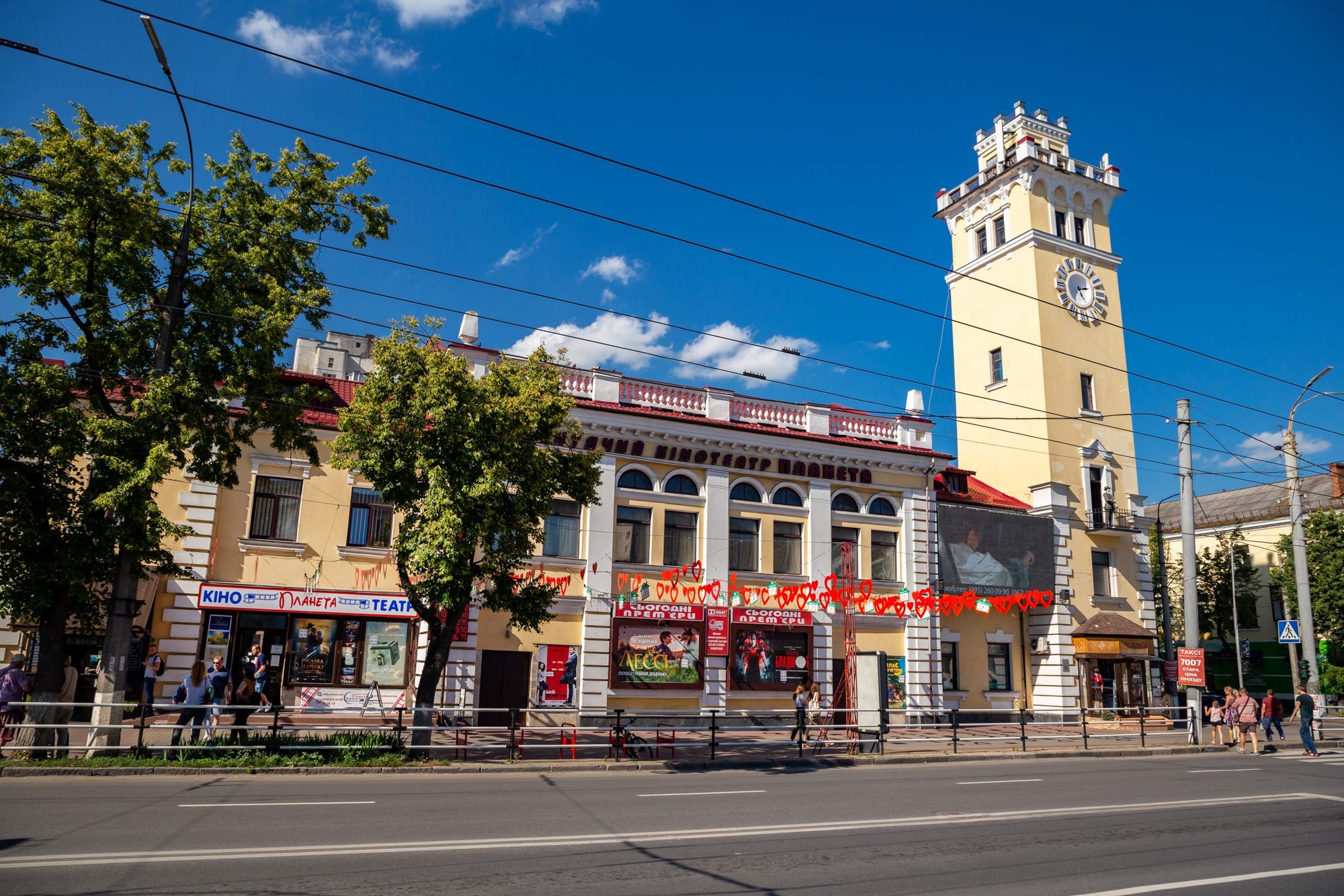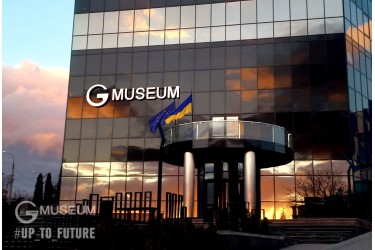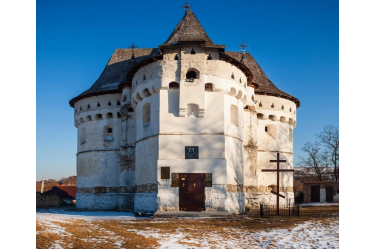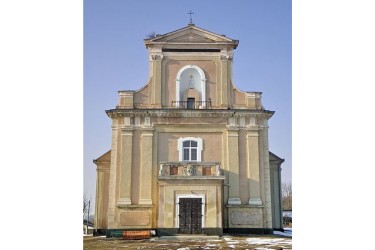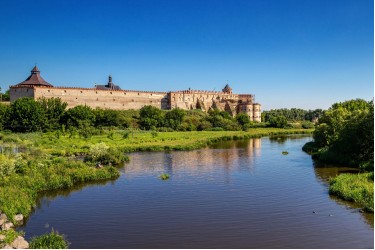5.7 km route
Start of the route: Proskurivska Street beginning
• Proskurivska Street: building №6 Kukhmisterska Khaseleva Restaurant (house of Lev Khaselev) → №7 (store of Vira Zhuravlova) → №13 (Derevoed pharmacy) → №15 (Elephant Restaurant) → №18 Music school (Illusion “Modern”) → Museum of Khmelnytskyi History → №40 Taras Shevchenko Cinema, №43 Khmelnytskyi City House of Culture (Shilman’s Theatre) → №33 (Peterburzkyi Hotel of merchant Sh. Skoletska) → №47 Khmelnytskyi Regional Art Museum (Industrial Bank) → №46 Dyven Khmelnytskyi Academic Regional Puppet Theatre (mansion of Marants) → №56 Museum-Studio of Photography (Continental Hotel) → The Angel of Sorrow memorial sign → Eternal flame → №83 Khmelnytskyi Regional Centre of Scientific and Technical Creativity of Youth (city public specialized school) → monument to Bohdan Khmelnytskyi on Pryvokzalna Square.
• Shevchenka Street: → №69 Kondfil Khmelnytskyi Confectionery Factory → №3 Museum of the Proskuriv Underground → №1 Institute of Teacher Advanced Training (former Jewish specialized school).
• Svobody Street
• Podilska Street: → №81 (building of Scheinberg “Kerosene store” and police team station) → №39 Planet Cinema (fire station) → №25 Museum-Library named after Roerich → №12 Khmelnytskyi Regional Museum of Local Lore.
Proskurivska Street
The central street of Khmelnytskyi runs from the intersection of Kamianetska Street across Soborna and Podilska streets to the railway station.
6, Proskurivska Street
It is two-story house, built in 1898. The owner was Lev Khaselev, whose initials “L.K.” preserved above the second floor window. A well-marked date has also been preserved: 1898. Lev Solomonovych Khaselev was one of the six freelance doctors in the city. On the ground floor of this building was a dental office, very well equipped as at the time. His apartment was on the second floor. Lev Khaselev also rented out a certain part of the house. In the twentieth century part of the facade was lost. In 2008 the attic floor was restored.
7, Proskurivska Street
The red brick house was built in 1903-1905. Its history is connected with trade development in the city – once there was the first and best gastronomic shop of Proskuriv, opened by merchant Vasyl Zhuravlov. “Zhuravlov’s Store” offered a wide choice of groceries and gastronomic goods, the opportunity to borrow goods and make orders, home delivery and tasting – all this was a surprise for the provincial Proskuriv. At the beginning of the XX century the store was renamed “Zhuravlova’s Store” because his daughter Vira Vasylivna became the owner of the company.
13, Proskurivska Street
The building in which Ukrtelecom departments are located can rightly be considered an adornment of Khmelnytskyi central street. It was built in 1890 by a nobleman Ludwig Derevoed, the owner of the best pharmacy in the city. In the basement was the wine “Rhine Cellar”, the first floor was occupied by a pharmacy, the second and third were given to tenants.
Part of the street from Volodymyrska to Soborna streets is pedestrian.
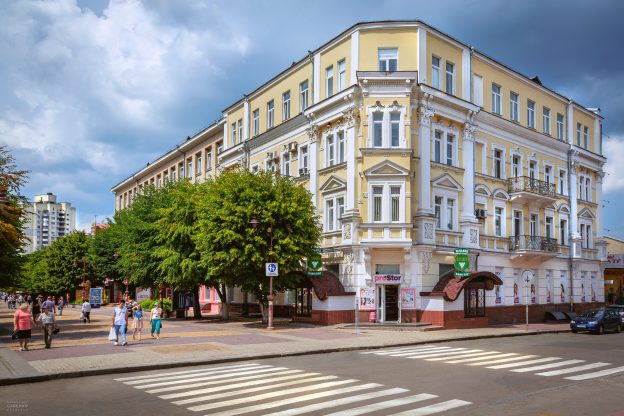
15, Proskurivska Street (Elephant Restaurant)
The name of the building comes from the shape of the facade of the building, which resembles the head of an elephant. There is information that once there was a balcony above the entrance to the restaurant, which was supported by elephant fangs, but to this day this balcony has not survived.
It is not known for sure who built this house, when and who was the founder of Elephant Restaurant. Possible date of foundation is 1890. But we can only say with certainty that in 1908 this restaurant was already operating successfully and was considered the best in the city. Elephant Restaurant has always tried to maintain its high brand. Unlike many similar places (as of 1909 there were 9 restaurants and taverns, 17 cook shops, snack bars and teahouses, 1 buffet, 39 pubs and wineries in Proskuriv), Elephant Restaurant offered visitors the most exquisite range. The restaurant cuisine was especially famous for its original cold appetizers and signature jellied fish, as well as a wide selection of wines and delicacies. It is said that even during the civil war, when famine and devastation prevailed in the country, it was possible to order (of course, for big money) black caviar and pineapples in Elephant Restaurant. Another “trump card” of the restaurant for a long time was the orchestra of blind musicians, consisting of 18 people who played in the evenings. Visitors specially came to listen to their virtuoso performance and ordered at least a cup of tea if they could not afford a more luxurious dinner.
Above the restaurant on the second floor were hotel rooms. Any traveler could stay in them, but mostly the rooms were used for other purposes.
In 2015 the facade of this building was reconstructed.
18, Proskurivska Street (Illusion “Modern”)
Khmelnytskyi Children’s Music School № 1 named after Mykola Mozhovyi is situated in this modernist style building at the beginning of Proskurivska Street. In 1910 it housed one of the first Proskuriv cinemas (illusion) called “Modern”, which was also the best illusion of the city. Entertainer announced the name of film and made a small description of it before the start of the show. Orchestral music sounded during the film demonstration.
The beginning of 20th century in the architectural life of the city was marked by the appearance of buildings in the neoclassical style. Its features can be seen on the facade of Modern Cinema. The lobby of the cinema was spacious and stood out with its style. Huge mirrors and a French tapestry were on its walls. The floor was made of ceramic colored tiles. The cinema had red velvet velum and curtains. The entrance doors of the cinema, which as well adorn the house in the 21st century, are decorated with climbing plants, made using the technique of artistic carving. With the onset of dusk the cinema in Proskuriv began to shine due to the electric lamps.
Museum of Khmelnytskyi History
The museum contains all epochs and everything what Khmelnytskyi and Podillia lived with since ancient times: from Tripillian clothes, knightly armor to military uniforms and flags from the ATO zone.
Here you can try on the clothes of nomads, take a picture in a knight’s helmet and flip through a huge album of old Proskuriv photographs. You can learn about the life of local residents in different historical periods, starting from the first written mention of the city, in the museum.
Carving, style and decor – everything in the museum conveys the spirit of past epochs.

Taras Shevchenko Cinema
It is central and one of the oldest operating cinemas in the city. The place has not changed its profile during its 80-year history. Currently the cinema hosts a demonstration of domestic and foreign films, various culture events and other public events.
Construction of the cinema began in 1936, and in the early 1940s the first film was showed there.
Taras Shevchenko Cinema (then named after Chkalov) became one of the best cinemas in the USSR. After it has survived the Second World War a small hall was added to it and the main one was expanded.

Khmelnytskyi City House of Culture (Shilman’s Theatre)
The oldest theatre in the city is to your attention!
In 1907 Borukh-Srul Shilman erected the first stone building of the theatre on the central Oleksandrivska Street (now Proskurivska Street). Next to it, in the courtyard, there was a small hotel for visiting actors and a cozy theatre restaurant. Theatrical life in Proskuriv revived: more and more often the best actors from Kyiv, Odesa, and St. Petersburg began to visit the city.
Throughout its centuries-old history the theatre has served many purposes, and eventually became the Khmelnytskyi City House of Culture. Although the building is somewhat hidden behind neighboring houses, its facade faces the main street of the city. Modernist style architectural structures built in the 20th century had common features. Such features are inherent in the building, which was once Shilman’s theatre. There are large windows, as well as pilasters and semi-pilasters in the design. The house has a slender composition.
Today many art groups work within the walls of Shilman’s Theatre, including Mirror People’s Amateur Theatre.
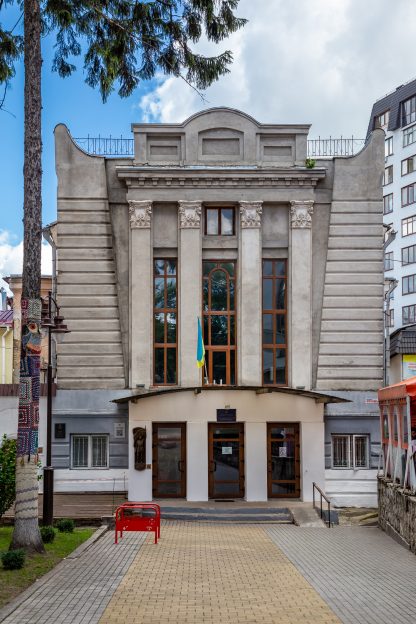
33, Proskurivska Street (Peterburzkyi Hotel)
This is a two-story house, on the ground floor of which are cafes and shops. It was built in 1897 and according to all information the Peterburzkyi Hotel was located here – one of the best in the city. The owner of the hotel was a local merchant Sh. Skoletska. Many famous people can be mentioned among the hotel guests. In 1901 one of Podillia music education founders, F. Hanytskyi, spent a few days driving to Kamianets-Podilskyi. In the autumn of 1905 the hotel hosted the first folk traveling exhibitions organizer Viacheslav Rozvadovskyi – a famous Ukrainian artist and teacher, founder of the Kamianets-Podilskyi Art School with a boarding school for rural children. An art exhibition was held in front of the hotel in one of the rooms of the city garden. Among the paintings were works of Rozvadovskyi, Repin, Kuindzhi, Makushenko, Bohdanov-Belskyi, Roerich. For the then Proskuriv exhibition became a real event in culture life.
47, Proskurivska Street (Industrial Bank and Khmelnytskyi Regional Art Museum)
A solid two-story brick house with a high decorative dome is well known to most Khmelnytskyi residents – the regional art museum has been locating here since 1986.
Over the centuries of its existence the building appearance has hardly changed, although many owners have changed: in the 1970s there were editorial offices of regional newspapers “Soviet Podillia” and “Korchahinets”, in the 1960s – the city party committee, in the 1950s – the regional executive committee… The house №47 was built in 1903 for the Proskuriv branch of the South-Russian Industrial Bank.
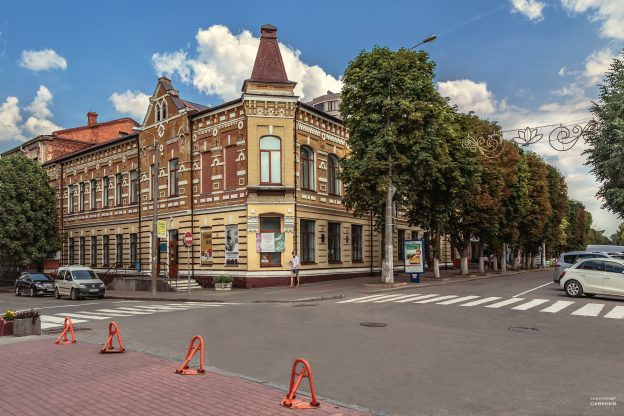
Puppet theatre
The two-story mansion was built in the 1880s, located in a beautiful garden, the manor had a wrought-iron fence outside. Subsequently the house was rebuilt several times until it acquired its final appearance: classic architectural forms, the main entrance, decorated with four columns and a balcony. At the beginning of the XX century part of the house was given for the needs of the Proskuriv zemstvo assembly.
The house was at the disposal of the headquarters of H. Kotovskyi separate cavalry brigade from the first days of Soviet authority, later there were various Soviet and military institutions. The 1930s brought the bad fame to the house with columns. At first, until 1938 there was a district branch of People’s Commissariat of Internal Affairs, and then, until the war there was a special unit of People’s Commissariat of Internal Affairs of the 5th Army Cavalry Group. Thousands of innocent people were killed in the basements adjacent to the house during the terrible years of Stalinist repression. Their remains were found in 1966 during the construction of a nearby Central Department Store.

56, Proskurivska Street (Continental Hotel)
This four-story building is a fine example of late Art Nouveau – the architectural style that dominated the early twentieth century. All the original plastic forms of the facade, openwork wrought-iron balconies, decorative wall decoration with colored smalt glass have been preserved to this day. Today music school classes are situated in the left wing of the building and there are almost a dozen different institutions and organizations in the central part. Here are an insurance company, a city financial department, a branch of the State Treasury, sport federations, newspaper offices, party offices … But once the whole house №56 was occupied by one of the best hotels in the city – Continental.
The Angel of Sorrow
The national artists of Ukraine, father and son Mykola and Bohdan Mazurs and architector V. Kozubenko created the monument-symbol that immortalized the memory of victims of violence, united and reconciled people of different generations and nationalities, people of different political views. The monument, erected in the city centre in 1998, is considered the only monument in the country dedicated to the victims of political repression. Granite and bronze depict a sad angel with half-lowered wings looking at the ground.

83, Proskurivska Street (city specialized school)
This two-story building is exclusively at the disposal of children from the first days of its existence and for a century. Today it is the regional centre of scientific and technical creativity of youth (until recently – the station of young technicians), previously the school was located here, and at the time of construction the building served the city specialized school needs. In 1869 as a result of another public education reform, it was decided to close the aristocratic specialized schools and turn them into city public specialized schools. Children from 7 to 12 years old were admitted to city specialized schools, the full study course lasted 5 years, the following subjects were taught: the Law of God, Russian with calligraphy, arithmetic, history, geography, natural science, church singing, drawing, as well as gymnastics, crafts for boys and needlework for girls. Another nuance – children education was separate, so there were two departments – male and female.
But back to the history of the school. For a long time it was located in cramped, unsuitable for study premises at the intersection of Soborna and Milionna (now Teatralna) streets, and therefore at the end of the XIX century there was a need to expand educational space. The problem was soon solved – in 1903 the construction of a new school building was completed on Oleksandrivska Street. In 1912 the city specialized schools were reorganized into higher primary specialized schools – four-year educational institutions, which admitted children from 10 to 13 years old after graduating from primary school.
Proskuriv City Specialized School was considered one of the best in the province, and that is why in 1909 “Permanent Pedagogical Courses” for teachers were opened under it.
The first monument to Bohdan Khmelnytskyi
The first historical monument to Bohdan Khmelnytskyi was erected in 1955. It depicts the hetman on horseback, holding a mace in his right hand bent to chest that is a symbol of state power. The authors are national artists of Ukraine, sculptors M. K. Vronskyi, O. Oliinyk.
Shevchenka Street
The street is located in the central part of the city and runs from Svobody Street to Trudova Street (near the railway station).
69, Shevchenka Street
This house is also an example of modernist architecture in Khmelnytskyi. There is information that this building belonged to Solomon Marants, as well as the steam mill, which was located at the modern “City Hospital” stop. The building once housed an alcohol-cleaning warehouse, which was later replaced by Kondfil Confectionery Factory.
Museum of the Proskuriv Underground
Once upon a time the secret apartment of the underground was housed in the museum. It was the centre of the Proskuriv partisan movement – an active underground organization in Ukraine during the Second World War. The initiators of the creation of the museum were veterans – members of the organization.
The museum contains personal belongings of the underground members, documents, archival materials, photos and videos. Today the exposition contains many old photographs of the underground members, a chair with a radio transmitter, helmets with bullet holes and much more. The updated funds of the museum allow you to study in detail the history of the city and its defenders who fought for the independence of Proskuriv.
1, Shevchenka Street (Jewish specialized school of the early twentieth century)
Jewish specialized school of the first category beautiful two-story building was built at the corner of Velyka Vokzalna and Starobulvarna streets (now Shevchenka and Svobody streets).
The story of Jewish education in the city will probably be relevant here. “A small Jewish school” is already mentioned in the description of the city in 1797. And at the end of the XIX century. statistics speak of eighteen cheders (Jewish religious primary schools), Talmud Torah and a number of private Jewish schools. There are several names of these schools owners: the owner of the men’s school was Zilberman, and the owner of the women’s school was Bondar.
The above-mentioned state Jewish specialized school was opened on October 14, 1851. New two-story building was built for the school at the expense of the city Jewish community at the beginning of the XX century. Regarding Jewish education in the pre-war period, it should be noted that in 1924 there were three Jewish schools in the city, and in 1927 – two. Documents from 1938 show that a Jewish incomplete secondary school was №2 in the city school network and also located in this building. Now a state institution works here.
Svobody Street
The street starts from Peace Avenue (the Zarichchia residential area), crosses the Southern Buh River and then runs through the central part of the city (to Pushkina Street).
Podilska Street
The street is located in the central part of the city and runs from the lowlands of the Ploska River (Shestakova Street) to the workshops of a furniture factory and Khmelnytskyi Confectionery Factory (Starokostiantynivske Highway).
81, Podilska Street (kerosene store, police station)
The two-story building at the intersection of Podilska and Hrushevskoho streets (formerly Komertsiina and Kupetska streets) was built in the last century and has remained almost unchanged to this day. This place was already crowded and popular then. Here was one of the first kerosene store in Proskuriv. The place belonged to tradesman L.Scheinberg. The store was a particularly authoritative place among residents, because a kerosene lamp was essential item at that time, so there was no end of buyers. Two large rooms of Dr. Bomstein were on the second floor of the building, and a drugstore and a grocery store were on the first floor. There was once a post № 4 of the local police department at the same intersection.
Planet Cinema (fire station)
The most significant building on the street is the building of the former fire brigade (the so-called “kalancha”), built in 1954 – now Planet Cinema. Its silhouette resembles ancient town halls in its forms and has become one of Khmelnytskyi architectural symbols. In 2004 a music clock was installed on the “kalancha” tower and in 2019 restoration of it took place, during which a real trumpet player Jacquemart was installed!
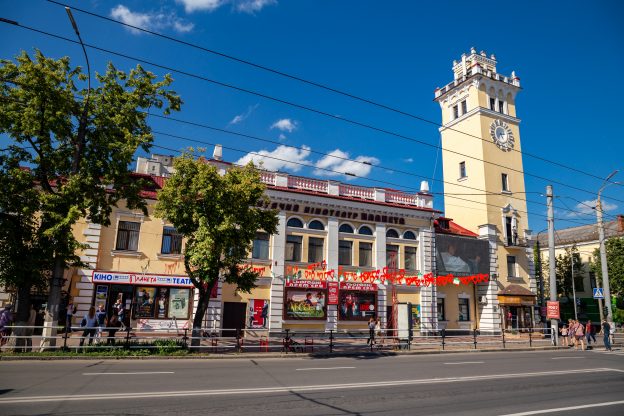
Museum-Library named after Roerich
An interesting library is located right next to the Planet Cinema, which is important for the development of the humane pedagogy movement in the city. It is about museum-library named after N. Roerich. The first meetings of the “museum workers” took place in the former premises of the puppet theatre. Lectures were held here on the Roerich family, Roerich Pact on the world culture heritage protection, on the meaning of life and other philosophical topics, which were attended by many Khmelnytskyi residents.
The first initiatives of Roerich Society were related to the culture heritage revival of the Podillia region. In particular, members of the society provided assistance in the restoration and archeological excavations of Medzhybizh Fortress.
Since 1995 the museum-library has been being located on 25, Podilska Street. Culture and Education Centre named after Nicholas Roerich is a little further near Philharmonic.
Museum of Local Lore
Khmelnytskyi Regional Museum of Local Lore is located in an elegant small three-story building near the centre of Khmelnytskyi.
The precursor of the local lore modern museum in Proskuriv was organized in 1929 – then the city museum of sanitary culture began its activities. The museum of local lore separated from it as an independent unit in 1933.
The museum in the city acquired the status of regional in 1941, when Proskuriv became the administrative centre of Kamianets-Podilskyi region.
Together with the renaming of Proskuriv to Khmelnytskyi (1954), the museum institution was renamed accordingly and got its modern name – Khmelnytskyi Regional Museum of Local Lore.

